A brief maritime history of Shoreham and its Fort
"For optimum view by mobile phone or other hand-held device, please click on the 'Text-Only' version at the bottom of this page"
Click here to make a donation to the Shoreham Fort restoration project, please, every little bit will help
If you like this page, how about clicking one of the buttons below left and sharing?? Just saying:))

Shoreham Redoubt, the Adur, and two thousand years of coastal defence.
Having recently responded to a request for help to try and dig up archive information for what I've always known as the Old Fort, I found myself returning to many different 'histories' of Shoreham in my quest, so I thought, why not try and bring them together for a brief history of the town in an attempt to explain why it should be considered important enough to warrant its own coastal fortification, also how that need was originally acted upon at least a thousand years ago during Norman times, and quite possibly a thousand years before that when the Romans ruled Brittania.
Shorehams history will always, inevitably, be linked with the River Adur, but it was a very different river and town as you drift back through the ages. For a start, the river apparently once used to go straight on towards the sea, as it passed by Ropetackle, with the Adur wide, and deep enough to allow ships of war as far upriver as Bramber. Over the centuries, the longshore drift from the west, has successively pushed the river mouth further and further east. This next paragraph, taken from Henry Cheals book, 'The Ships and Mariners of Shoreham', (originally written in 1909), gives an eye opening insight as to how this whole area would have once appeared:-
---------------------------
'The Adur now passes through the narrow valley--generally known as the Shoreham gap--which in the course of centuries untold it has cut between the chalk hills, and which rise to the east and west in places somewhat abruptly. That this valley was once under the sea-waters of an estuary which extended from Aldrington to St Cuthmans Port (Steyning), and, as we have seen, washed the mound of Bramber Castle, is not difficult to realise; the ancient banks may be easily traced along the road to Botolphs, also in the parish of Coombes; at the Sussex Pad Inn, and in a south-westerly direction at Lower Lancing towards the sea.'
In the remote times, when doubtless the Roman galleys were to be observed riding on the waters of this haven, this valley must have been strikingly beautiful, the slopes of the Downs on either side were then covered with a forest-- part of the great Wealden forest of Anderida, which then covered nearly the whole of Sussex, and whose dark jungle and trackless depths were little known. The haven then extended over many acres of now dry land, including the low-lying levels of Lancing opening out into the estuary before named, which was bounded towards the south-east by a large promontory stretching to a point almost opposite Aldrington, where the estuary opened into the channel. The promontory has long been submerged.'
----------------------------
So there you have it, the sea lapping the shore as far up as Bramber, which was quite possibly known to the Romans as Port Adurni. That there was a Port Adurni in Roman times is not disputed, but unfortunately its exact location as our River Adur, is not proved beyond doubt, as yet, although the evidence is quite strong to support the theory. I've often wondered whether there may be archeological evidence directly under Bramber Castle, as presumeably that would have been just as ideal a position for the Romans as it proved to be for the Normans a thousand years later. Perhaps advanced archeological technologies will one day help us to discover one way or another if that were the case.
Between the Romans and the Normans, there came the Saxons, invading these shores during the fifth century, some landing at Cymensora, (Shoreham, is believed to possibly be this site), driving out the 'Welsh', as the Saxons referred to the inhabitants. Cymensora is apparently the place in Southern England where according to the Anglo-Saxon Chronicle, Ælle of Sussex landed in 477 AD and battled the Welsh with his three sons Cymen, Wlencing and Cissa, Cymensora being named after the eldest son. There is no difinitive proof as to the actual location of Cymensora yet, and the Selsey area is also cited as a possible candidate. It is also to be noted that the Romans had German tribesmen in their legions, and many of them are believed to have stayed in Britain after the Romans left. Combining with the effects of the arrival of even more Angles and Saxons in the following years, it was not long before the indiginous Britons had been driven West, out of this part of England completely, or wiped out, we can only speculate at this time. Perhaps advancing technology will bring some answers to this particular puzzle too.
Shoreham, and Adur's history is inevitably linked with ship building, in fact, Shoreham was at one time called Hulksmouth, Hulks being the name for ships centuries back. There is an ancient borough seal inscribed, 'By this sign of a hulc is Hulcsmouth proclaimed a harbour, and so is right worthily named'. The earliest deed referring to Shoreham as Hulkesmouth is 1302, relating to a right of ferry, 'across the water of Hulkesmouth'. Hundreds of years later, one of the benefits of Shoreham as a ship building town, was recognised by Navy contractors, who apparently favoured Sussex oak above all else.
This is a tract from famed writer Daniel Defoe's three volume book, 'A tour thro' the whole island of Great Britain, divided into circuits or journies', written between 1724 and 1727. After leaving Brighthelmstone (Brighton), Defoe writes:-
'From hence, still keeping the coast close on the left, we come to Shoreham, a sea-faring town, and chiefly inhabited by ship-carpenters, ship-chandlers, and all the several trades depending upon the building and fitting up of ships, which is their chief business; and they are fam'd for neat building, and for building good sea-boats; that is to say, ships that are wholesome in the sea, and good sailors; but for strong building, they do not come up to Yarmouth, Ipswich, and the north.
The builders of ships seemed to plant here, chiefly because of the exceeding quantity and cheapness of timber in the country behind them; being the same wooded country I mentioned above, which still continues thro' this county and the next also: The river this town stands upon, tho' not navigable for large vessels, yet serves them to bring down this large timber in floats from Bramber, Stenning, and the country adjacent; which is as it were all covered with timber.'
---------------------------------------
Once eventually the original harbour entrance had been shifted along to its present position, it took the intervention of man to rescue Shorehams position as a viable working harbour, its success later validated by the arrival of the railway in 1840. The by product of the long shore drift which almost finished Shoreham off as a marine trading town, was the peninsula that formed to become what is now Shoreham Beach, or Bungalow Town as it was known in its infancy. This brings me neatly, if not thoroughly, to our Shoreham Redoubt, which is situated right at the end of our peninsula, at the west side of the harbour entrance as it is today.
The importance of Shoreham as one of many possible landing stages for an enemy incursion was recognised in the 1850's by the then Prime Minister, Lord Palmerston, owing to the perceived possibility of an invasion by the French, and the speed with which an aggressor could reach our shores with the newest steam driven ships. The fortification was completed by 1857, although it is generally accepted that all of these coastal redoubts, and their guns, were obsolete by the time they had been made ready for action. Despite that fact, Shoreham Redoubt would appear to have been permanently garrisonned at least until the 1890's, with census reports for 1861, 71, 81, and 91, all showing ranks of the Army/Royal Artillery stationed there, often with their families living with them in the barracks.
.
Addendum:- I have since found an old newspaper article from 1864 which explains the volunteer/professional soldier situation. I have added the new information at the bottom of this brief history.


The Redoubt census reports:-
1861
No1 Officers barracks
Matthew Renham. Master Gunner, Army Artillery. Born 1825 Chesterton, Cambridgeshire
Rebecca " . Wife. 1827 Cromer, Norfolk
Matthew " . Son. 1856 Chesterton, Camb's
Ellen " . Daughter. 1852 Exeter, Devon
Martha " . " . 1854 Cromer, Norfolk
Sarah " . " . 1859 Tynemouth, Northumberland
Christiana " . " . 1860 Devonport, Devon
George Chamberlain. Nephew. 1857 Cromer, Norfolk
No2 Room. Soldiers
Isaac Babe. Bombadier. Born 1824 Ireland
Margaret " . Wife. 1831 "
Eliza " . Daughter. 1852 "
Ann " . " . 1856 Woolwich, Kent.
Margaret " . " . 1859 Glamorgan, Wales
Patrick Kavanagh. Gunner. 1820 Ireland
Mary " . Wife. 1830 Liverpool.
Frank " . Son. 1855 Woolwich, Kent
Ciscilie " . Daughter. 1857 Ireland.
John " . Son. 1859 Lancing
John Carroll. Gunner. 1831 Manchester
Jane " . Wife. 1831 Farnham, Surrey
John Garters. Gunner. 1827 Ireland.
Joseph Lunt. " . 1827 Staffordshire
Luke Parris. " . 1824 Arlington, Sussex.
Sarah " . Wife. 1806 Hampshire.
Arthur Porter. Gunner. 1835.
Sarah " . Wife. 1838 France- British subject
Amelia " . Daughter. 1857 " " "
Eliza " . " . 1860 " " "
John De Velling. Gunner. 1821 Penzance, Cornwall.
Sarah " " . Wife. 1839 Portsmouth, Hampshire.
Frederick W " " . Son. 1860 Lancing, Sussex.
Just looking at the dates of birth of the children you can tell they moved about quite regularly, and a number of the locations were in fact towns with their own fortifications similar to the Shoreham Redoubt, while the Woolwich Royal Artillary barracks are known as the home of the Royal Artillary, and, as any Arsenal fan will tell you, where the nickname of 'The Gunners' comes from, as they were originally the 'Woolwich Arsenal'.
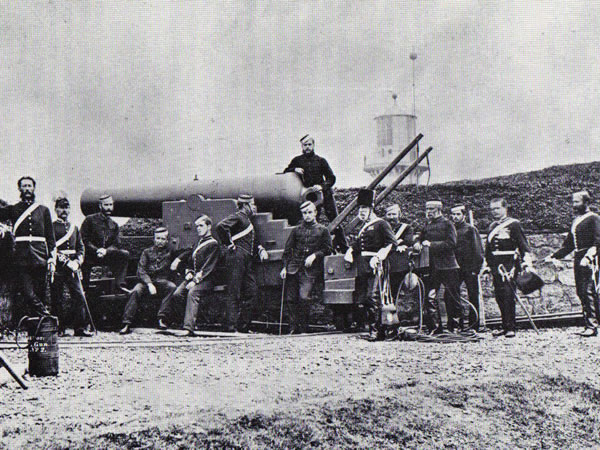
The picture above was apparently taken at Heugh Battery, Hartlepool, circa 1870, to give an idea of how the Coast Brigade and Sussex Volunteers at Shoreham Redoubt may well have looked.
By the time of the 1871 census, it seems curious that there are far fewer families living at the redoubt, just Bombadier Robert Suggett with his wife, Elizabeth, and Gunner John Bicknell, with his wife, Jane, and daughter, Helen. However, there is still the widespread mix of locations from which the Artillery men originate.
1871 Shoreham Redoubt Census report .
George Austin. ---------- Corporal Royal Artillery. ----------- 1837 Shepherdswells, Kent.
Robert Day. ------------- Bombadier R A. ------------------ 1838 Scotland.
Samuel Adams. ---------- Gunner R A. ---------------------- 1841 Liss, Norfolk.
George Hillier. ------------ Gunner R A. ---------------------- 1833 Steeple Ashton, Wilts.
Richard Moulding. --------- Gunner R A. ---------------------- 1835 Penrith, Cumberland.
John Seymour. ------------- Gunner R A. ---------------------- 1833 Shafford.
Cornelius Shea. ------------ Gunner R A. ---------------------- 1830 Surrey.
John Bicknell. -------------- Gunner. R A. ---------------------- 1833 Willand, Surrey.
Jane Bicknell. ---------------- Wife. ---------------------------- 1845 Wiltshire.
Helen Bicknell. --------------- Daughter. ----------------------- 1870 Cheriton, Kent.
Robert Suggett. ------------- Bombadier R A. ----------------- 1831 Scotland.
Elizabeth Suggett. --------------Wife. -------------------------- 1833 Ireland.
Robert Taylor. -------------- Master Gunner R A. -------------- 1831 Woolwich, Kent.
After checking through the later census records, I discovered that John and Jane Bicknell had two more children after Helen, both of them born in Shoreham. The 1881 census shows Jane Bicknell, now a widow, living with Helen, John, and William A Bicknell, in Queen street, Honiton. John, (1872), and William, (1875), places of birth given as Shoreham, Sussex, so it would appear that John and his family were stationed there for at least four years. Further research showed John Bicknell junior to have been born at, 'The Fort, Lancing', 14 March 1872, John senior listed as, 'Soldier, Gunner, Royal Artillery'. Just two years later John senior died, on 28th October, 1874, at the Military hospital, Preston barracks, Brighton, of valvular disease of the heart. He was listed as being a, 'Gunner, Royal Artillery, (Coast Brigade)'. The receipt of his youngest son, William Albert Bicknell's, birth certificate, revealed an even sadder chapter to events, he was born just over five weeks after his father's death, on 6th December 1874, and their address was given as, 'High street, New Shoreham', so they had obviously had to move out of the fort barracks soon after the death of Gunner John Bicknell.
Unfortunately this family story gets even worse by the 1891 census, as the three children are listed as, 'Inmates', living in the Union House, Honiton, their mother, Jane, having died in 1887. They are all listed as having occupations, Helena, as a domestic servant, John, as a painter, and William, a labourer. A Union House is just another name for a Workhouse, usually very unpleasant places to be forced to live in.
1881 Shoreham Redoubt Census report.
James Kerr. --------------Corporal Royal Artillery.-----------------1837 Ireland.
Mary Kerr. -----------------------Wife. --------------------------- 1845 Ireland.
Mary Kerr. --------------------Daughter. -------------------------- 1872 Ireland.
Matilda Kerr. --------------------- ". ------------------------------- 1874 Maker, Cornwall.
Richard Kerr. -------------------Son. ------------------------------ 1876 St Ives, Cornwall.
Daniel E Kerr. ------------------- " .-------------------------------- 1878 St John, Cornwall.
Eugenie M Kerr. -------------- Daughter. --------------------------- 1880 St Germans, Cornwall.
George Davis. -------------- Bombadier R A.----------------------- 1843 Windsor, Bucks.
Annie Davis. -------------------- Wife. ----------------------------- 1858 Woolwich, Kent.
Annie Davis. ------------------ Daughter. --------------------------- 1881 Shoreham, Sussex.
Annie (Guire?). ------------- Mother in law. ------------------------- 1823 Buckinghamshire.
James Beines. ---------------Gunner R A. --------------------------- 1840 Killyman, Ireland.
John Moore. ----------------Gunner R A. --------------------------- 1837 Tunbridge, Kent.
James Kerr and his family turn up in Littlehampton by the 1891 census, and it explains a bit more
1891 Littlehampton census report:-
Address:-
Battery House, Pier road, Littlehampton
James Kerr. ---------------- Sergeant R A.-------------------------- 1838 County Antrim, Ireland.
Mary Kerr. --------------------Wife--------------------------------- 1847 County Antrim. Ireland
William Jas. Kerr.------- Son.-- Scholar.----------------------------- 1871 County Antrim, Ireland.
Daniel E Kerr. ---------- Son.-- Scholar.----------------------------- 1878 Plymouth, Devon.
Eugenie M Kerr. -----Daughter.-Scholar.----------------------------- 1880 Ditto. No 4 Redoubt.
Edward M Kerr.-------- Son.---Scholar.----------------------------- 1884 Shoreham, Sussex.
Edith Agatha Kerr. ---Daughter.-Scholar.----------------------------- 1885 Littlehampton, Sussex.
Victoria Kerr.---------Daughter.-Scholar.----------------------------- 1888 Littlehamton, Sussex.
So it would appear, (with Eugenie born at the Redoubt posting in Devon in 1880, Edward being born in Shoreham, 1884, then Edith, born Littlehamton, 1885), that James and his family were stationed at Shoreham for about three years before he was relocated to the Littlehamton Redoubt. James lived out the remainder of his life in Littlehampton, his Probate listing him as a Sussex Army Pensioner, having died on the 31st December 1912, leaving his widow, Mary £217 17 shillings, and 7 pence.
----------
George and Annie Davis also had another child while stationed at Shoreham, Georgina, born 1883. When they had their next child, Clara Catherine, 15th Feb 1886, their address on the baptism certificate is, '10 Coupland Terrace, Plumstead', and George's occupation is stated as being, 'Fireman, Royal Arsenal', so it appears he had been relocated by then. With a bit of leeway, we can say that George and family were at Shoreham Redoubt for at least two, and maybe up to five years.
-----------
1891 Shoreham Redoubt census report
Joseph Burrows-----Sergeant, Royal Artillery------1842 Cheltenham, Gloucestershire
Bridget Burrows----------Wife--------------------1850 Uppottery, Devon
Anna E----------------------Daughter------------------------1883 Oystermouth, S.Wales
Maud M---------------------Daughter------------------------1884 St Just in Roseland, Cornwall
Mable B---------------------Daughter------------------------1885 Folkestone, Kent
Alice E----------------------Daughter------------------------1887 Lancing, Sussex
Joseph F----------------------Son----------------------------1890 Lancing, Sussex
Thomas Hatcher----Gunner, Royal Artillery----------1847 Saxmundham, Suffolk
Mary E------------------------Wife------------------------------1860 Shoreham, Sussex
Annie E--------------------Daughter---------------------------1889 Lancing, Sussex
Jane E Brooker-----------Sister------------------------------1884 Eastbourne, Sussex
John Andrews------Gunner, Royal Artillery-------------1848 Sladesbridge, Cornwall
Jane Andrews-----------------Wife----------------------------1854 Dorset, England
Bulnell Andrews---------------Son----------------------------1879 Dorset, England
Elizabeth Andrews-------Daughter-------------------------1884 Dover, Kent
In the 1911 census, I found the Burrows family living at 21 Marle Hill Parade, Cheltenham, and Bridget is now a widow, but they had one more son, John William Burrows, born at the Shoreham Redoubt on the 10th November 1891.
The Fort Children
There had been a certain amount of speculation regarding the status of the soldiers at Shoreham Redoubt, with a view that it was a volunteer manned fort, and this puzzled me from the beginning, as clearly the census reports showed professional soldiers barracked there, and their children often having been born at other fortifications around the country. To find out more, I decided to look further on and follow the lives of the married couples, as well as tracing the birth certificates of the children stated as having been born in either Shoreham or Lancing on the census reports.
So far I have discovered 12 children born in Shoreham, all but one having been born at the Fort itself. The earliest birth I found, was for Frederick William de Velling, born on the 17th January 1860 at, 'Shoreham Redoubt, Lancing', (residence same). His father, John de velling's occupation given as, 'Gunner, Royal Artillery'. There appears to have been an earlier birth of a son at the Fort, to another Gunner, Patrick Kavanagh, in 1859, but I haven't been able to trace a record to confirm it yet.
.
The next set of births unveil what becomes a sad tale. John Bicknell, a Gunner at the fort in the 1871 census, with his wife, Jane, had just the one child at the time, Helen, 8 months old, who was born in Cheriton, Kent. I have told this story further up, but since then I discovered that Gunner John Bicknell died at Preston Barracks Hospital, Brighton, of 'valvular disease of the heart', 28th October 1874, his occupation given as, 'Gunner, Royal Artillery, (Coast Brigade)'. When I received the birth certificate of his youngest son, William Albert Bicknell, he had been born a few weeks after his father's death, 6th December 1874. It would appear that with the death of her husband, Jane Bicknell had also lost their quarters at the Redoubt, as William was born in the High Street, New Shoreham, the address given as their residence too. So William seems to be the only child borne of a Fort soldier, not to be born at the Fort itself. His elder brother, John, was born '14th March 1872 The Fort, Lancing', residence stated as, 'The Redoubt, Lancing'.
Annie Jane Davis, daughter of George Davis and his wife, Annie, was born '21 March 1881, The Redoubt, Lancing', occupation of father, 'Bombadier, Royal Artillery', residence given as, 'The Redoubt, Lancing'.
Edward Kerr, son of James and Mary Kerr, was borm, '19th October 1883, The Redoubt, Lancing', his father's occupation given as, 'Sergeant, Royal Artillery'. Name and residence of informant, 'James Kerr, Battery House, Littlehampton, (after declaration dated 20th November 1883)'.
.
I only recently discovered the 1891 census for the Shoreham Redoubt, which like all the others, was listed as part of the Lancing district, doubtless owing to the fact there was no land link to Shoreham at that time. When I did find it, there were a few more fort babies, and the first marriage by a professional soldier stationed there, to a Shoreham girl, so far at least.
.
Sergeant Joseph Burrows, and his wife, Bridget Coles Burrows, (nee Fennimore), had three children born at the Shoreham fort between 1887 and 1891, they were:-
Alice Ethel- 29th November 1887, Joseph Francis- 19th October 1889, and, John William- 10th November 1891.
Their marriage, and subsequent first three children's birth places give an idea of the movements of Coast Brigade soldiers. Married at Plymouth, Devon, in 1881, their first child, Anna Elizabeth, was born at Oystermouth, South Wales, 1882, their next child, Maud Maria, was born at St Just in Roseland, Cornwall, in 1884, and their third child, Mabel Bridget, was born at Elham, Kent, in 1885, all locations close to coastal fortifications. I would expect the birth certificates to show they were living in fort, redoubt, or battery, barracks.
.
Next up we have our first record of a marriage, between Corporal Thomas Hatcher, Royal Artillery, resident of Shoreham Redoubt, to Mary Elizabeth Brooker of Kingston by sea, on the 3rd September 1887, at the parish church of Kingston by sea. Mary was Shoreham born, to George and Mary Ann Brooker, while Thomas came from Saxmundham, Suffolk. Their first child, Annie Elizabeth, was born at Shoreham Redoubt, 13th December, 1888.
.
So we know that full time professional soldiers occupied, not just the Shoreham Redoubt, but redoubts, forts, and batteries, all around the coast of Britain, until at least 1891, but it was a news article from The Brighton Gazette, 27 October 1864, which shed proper light on the situation.
.
Firstly, below are some of the Fort babies birth certificates, the death certificate of John Bicknell, Gunner, Royal Artillery, (also pictured below), dying just weeks before the birth of his last son, William Albert Bicknell, in 1874.
The photo below of Gunner John Bicknell was kindly supplied by the great great grand daughter of his sister, Elizabeth (1852).
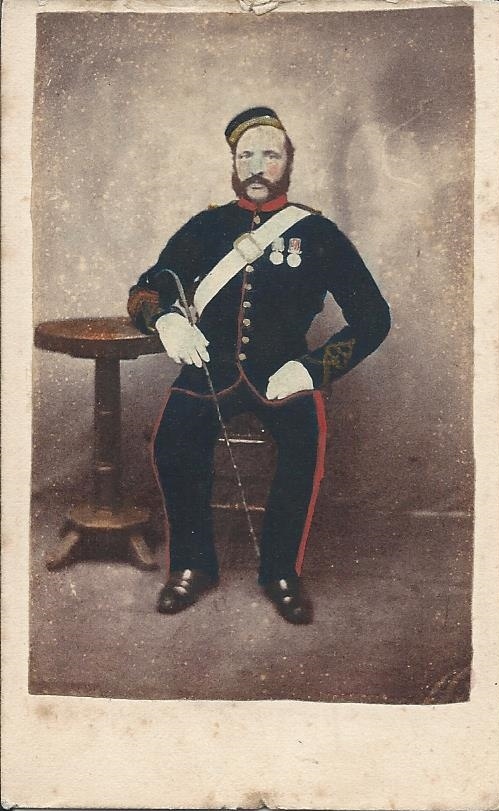

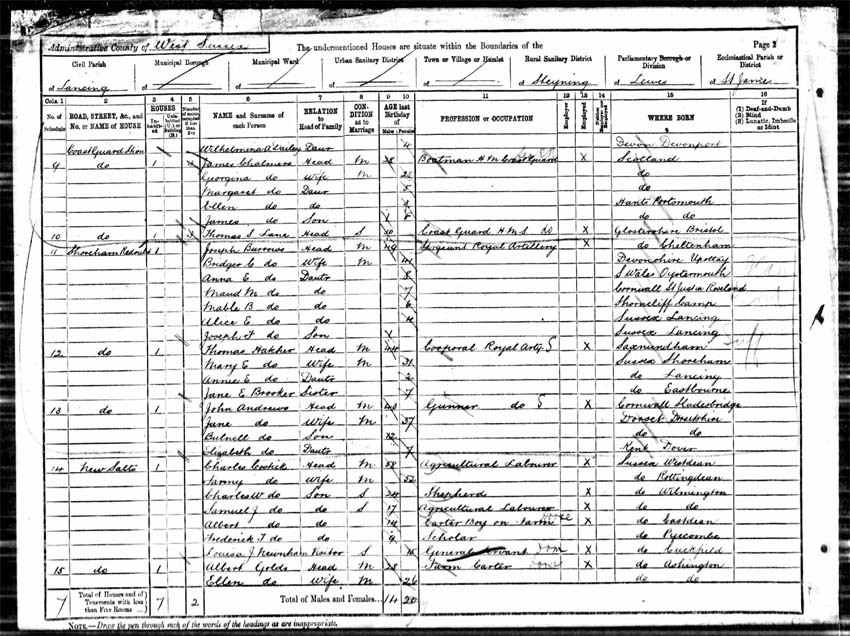
Shoreham Fort, Volunteers, Professionals, Babies
.
Researching the Fort history has been an ongoing pastime for some while, but recently I have unearthed a few gems which help explain the position regarding the status of the Fort soldiers. From the beginning I had believed the fort to be garrisonned by professionals, and indeed it was built to accommodate as such, but there is also a wealth of evidence suggesting the heavy involvement of volunteers, or militia. So we know without doubt there were professional soldiers stationed at the fort, it would seem, for the entire time it was manned, but it took a couple of old newspaper stories to shed new light upon this mystery.
.
The first story I came across, in the Brighton Gazette, dated 27 Oct 1864, (full article shown below), told of a cracked gun at the fort needing to be changed, explaining how the guns had previously been fired, 'partly by the Coast Brigade, and partly by the late 4th Sussex Shoreham and 1st Sussex (Brighton) Volunteer Artillery.' . It states further on how, 'the gallant Major of the 1st Sussex Volunteer Artillery is always anxious for the corps to learn something about gun mounting, and to the small number of the Coast Brigade stationed at Shoreham being insufficient to perform the task, he offered to dismount the old gun, and remount the new one'. So there you have it, proof evident of professional and volunteer working side by side. I expect that day must have been one of excitement for the people of Shoreham, seeing a large detachment of soldiers alighting at Shoreham station, with a 12 foot barrelled gun to replace the condemned fort gun. With no footbridge to cross, I don't imagine they would have floated a heavy gun like that over the river, but who can say. I rather imagine they would have marched through town, across the old Norfolk Suspension Bridge, and around close to where the river footpath meets the Brighton road. Where were the photographers then??
.
It was an article I found in the Newcastle Journal, dated 12th Nov 1859, which finally nailed the situation, and gave a surprising addition to the story. The headline was 'The Coast Brigade of Artillery', and the column begins, "Horse Guards, S.W., Nov.1. Her Majesty having been pleased to approve of an augmentation to the Royal Artillery of one major, seven captains, eight lieutenants, one sergeant-major, one quartermaster sergeant, five staff-sergeants, 24 sergeants, six corporals and bombardiers for the purpose of forming a new brigade, to be called the 'Coast Brigade of Artlillery', the present invalid artillery being amalgamated therewith'. Further on it says, 'As its name implies, the Coast Brigade will be distributed among the forts, batteries, and towers of the United Kingdom'. Towards the end the article explains, 'The instruction of the Volunteer Artillery companies will be one of the principal duties of the brigade, and too much attention cannot be paid to uniformity in the manner of imparting instruction'
.
This letter was signed off, 'By command of his Royal Highness, "The General Commanding-in-Chief. "G.A.WETHERALL, Adjutant General"
.
Further investigation revealed that an 'Invalid Detachment', which had been in operation since the late 1700's, was replaced by, and incorporated into, the newly formed, 'Coast Brigade', in 1859, which operated within the Royal Artillery, manning the forts, towers, and batteries, around the coasts of Great Britain and her dependencies. The Coast Brigade was eventually disbanded itself in 1891.
.
So there you have it, the Coast Brigade appears to have been an early version of Dads Army, with the Coast Brigade integrating invalided soldiers to man the forts, and train the volunteers, if we can't get a TV show out of this then there's something wrong! After all, Nicholas Lyndhurst's Grandfather, Francis L Lyndhurst, was making films at the fort just a few years after the last soldiers left, and with Nicholas having played the time traveller in Goodnight Sweetheart, surely a script almost writes itself.
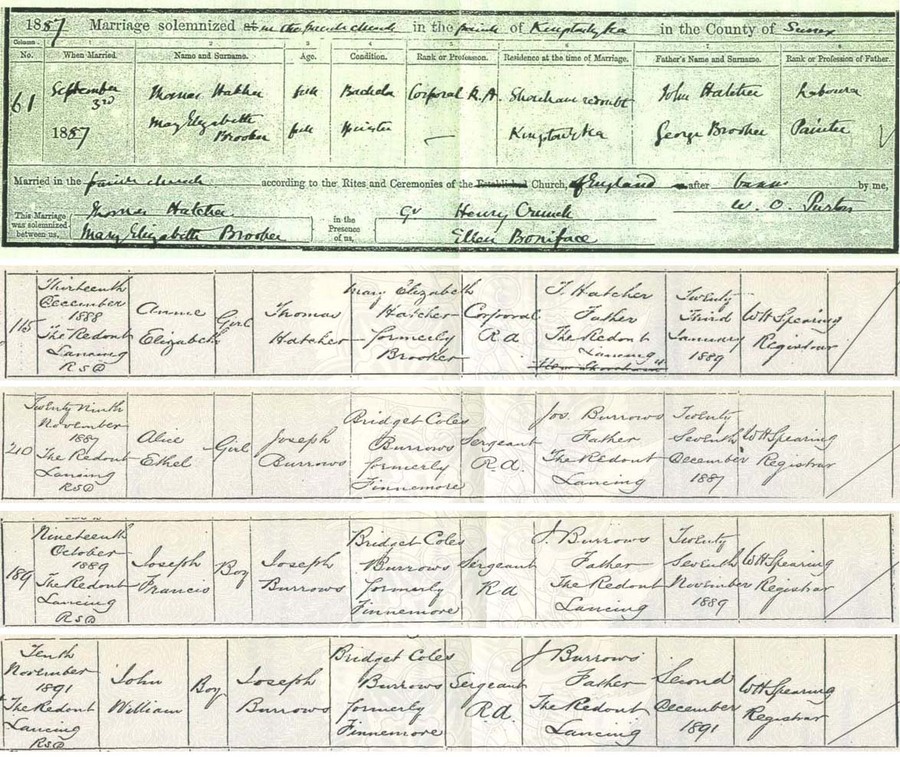
Please feel free to click on one of these buttons and share this with your friends, just sayin'!

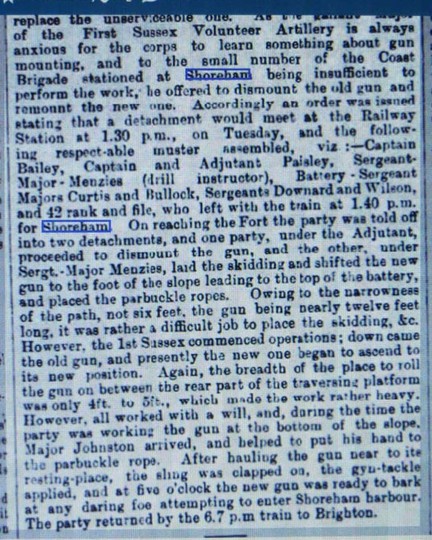
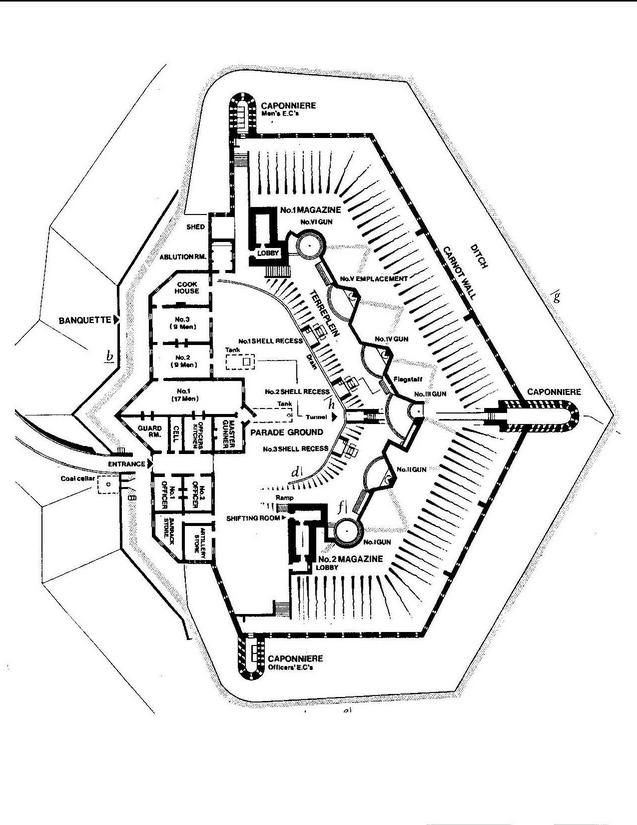
Click this link to find the Friends of Shoreham Fort, and please 'Follow' them, and 'Like' their page
|











